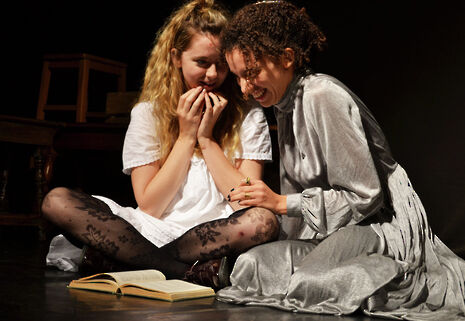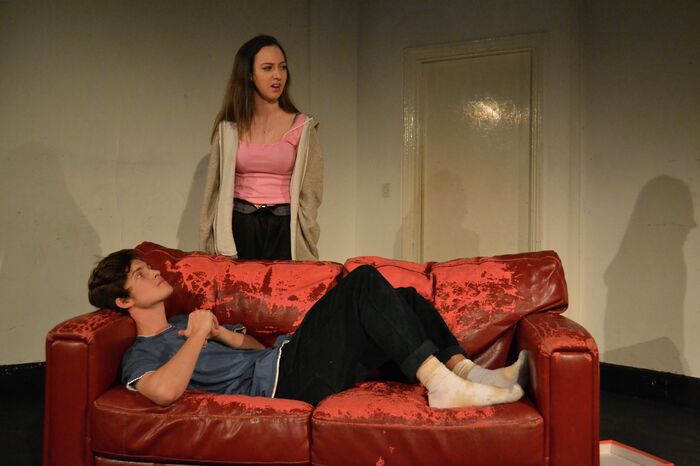Jane Eyre is beautifully acted but is without the energy of the novel
Georgina Deri’s production of Polly Teale’s adaptation doesn’t quite manage to translate the classic to the stage.

If you’re going to go for realism in theatre, you have to do it really well. I’m not talking about the individual actor plumbing the depths of their character and nailing emotional nuance; realism is a group effort. It needs a total atmosphere which makes us believe the emotions and interactions unfolding in front of us. This is where the production of Jane Eyre at Robinson Auditorium falls short.
The story of Jane Eyre, Mr Rochester and Bertha Mason is one with which most of us, I would hazard a guess, are at least vaguely familiar. We remember the novel’s interest in the Jane-Rochester dynamics: painfully complex and tensely sexual; moving from proud self-defence to unbounded emotional expression. We remember the suspended passion of their first meeting when Mr Rochester has fallen off his horse.
But this feeling of something dawning, of speech (and love) on the cusp, sadly doesn’t carry through into this production. The event occurs too randomly, with not enough atmospheric build-up, and the lines seem to rush to their conclusion. I didn’t believe that there was any potential feeling between the two characters. I understand the problem (that 18th-century novels have just so many individual “scenes”) but Director Georgina Deri and assistant Jenny Lazarus would have done well to extend each scene a little, cutting less important ones and focusing instead on creating atmosphere to make the audience believe in the emotional experience.
The play was not without compelling moments; however, these tended to be those that leaned towards stylisation, especially in the final depiction of the fire at Thornfield, or Jane’s dream on her wedding night, when Bertha (Imani Thompson) and Jane (Kay Benson) flirt with her veil, or the re-enactment of Mr Rochester and Bertha first falling in love as they dance. The screen hanging down to cover a raised part at the back of the stage creates a wonderful sense of the opacity of secrets and becomes a visualisation of the way in which those in power hide the women who embarrass or threaten their way of life. These more stylised moments highlighted that dramatizations of long and complexly-plotted novels need symbolism, style and creativity to refresh and reinvigorate them. Deri and Lazarus’s version of Jane Eyre gestures at these moments – but I wanted more.
The production is certainly clean and visually tight; the woodenness of the stage effectively focuses the audience, and the smoothness with which set (designed by Lucie Richardson) – mainly washing, bedsheets and dresses – was unfolded, unfurled and then folded again, packed away and stored in boxes on the stage was immensely impressive. Margaret Hornet’s costume had aesthetic coherence and there was no corner cut in the quest for “authentic” simplicity. Georgia Rawlins’s musical compositions, performed by musicians onstage (Daniel Quigley, Esme Cavendish and Sophie Iddles) who complement the drama without intruding into it.
Benson, as Jane, elegantly commands every moment she is on stage, displaying impressive vocal subtlety and emotional nuance; her Jane is a young woman caught between the necessity and desire to speak her mind and the certainty that if she does so she will be transgressing her allotted social position. Praise must also be heaped on Charlotte Horner (Helen/Adele/Mary), particularly for her role as Adele, where she captured both the subtle and overblown mannerisms of a little girl easily bored by work and easily charmed by the gift of a new dress. The scenes between Adele and Jane flow confidently and smoothly, generating through their conflict or cooperation the crucial atmosphere which is lacking at other points of the play.
"The play was not without compelling moments; however, these tended to be those that leaned towards stylisation"
Putting on a retelling of an 18th-century novel, especially a novel as famous as Jane Eyre, is no easy task. The realistic and the stylised compete for a place onstage, and the lines in the script can sometimes seem so obvious that it is hard to act them with subtlety. There is definitely potential in this cast and crew – there were moments of directional brilliance and a number of impressive acting performances – but they didn’t quite persuade that Bronte’s novel works as a piece of theatre. Dedicate more energy to mood-creation in each of the scenes, play up the stylised moments – and I might soon be convinced.
 Features / How sweet is the en-suite deal?13 January 2026
Features / How sweet is the en-suite deal?13 January 2026 Arts / Fact-checking R.F. Kuang’s Katabasis13 January 2026
Arts / Fact-checking R.F. Kuang’s Katabasis13 January 2026 News / SU sabbs join calls condemning Israeli attack on West Bank university13 January 2026
News / SU sabbs join calls condemning Israeli attack on West Bank university13 January 2026 Comment / Will the town and gown divide ever truly be resolved?12 January 2026
Comment / Will the town and gown divide ever truly be resolved?12 January 2026 News / 20 vet organisations sign letter backing Cam vet course13 January 2026
News / 20 vet organisations sign letter backing Cam vet course13 January 2026










